The first thing any photographer wants to know about a piece of gear is how well it works. Camera equipment is expensive, which is why photographers spend so much time sifting through reviews before making purchasing decisions. For some of the more specialty lenses, photographers test the waters with accessories like wide-angle lens converters. These are much cheaper than buying the lens itself.
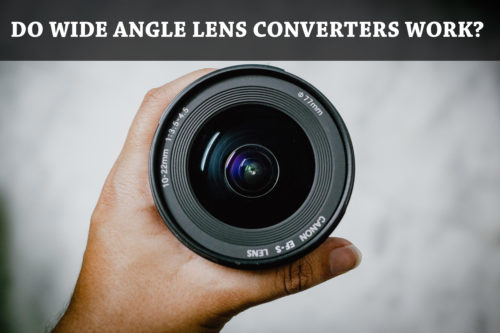
But do wide angle lens converters work?
In the right situation, they can be an excellent accessory. If you’re a hobbyist photographer or just want to play around with different styles, they are an inexpensive way to get your feet wet. However, if you plan to shoot real estate or landscapes professionally, it would be best to invest in a quality wide angle lens.
Still interested? Let’s learn all about lens converters.
What Are Lens Converters?
You can attach a lens converter to your lens to extend the functionality of the lens. The technical difference between a lens converter and a lens adapter is that while a converter increases your capabilities with your current lens, an adapter allows you to use a lens on your camera that has a different mount than your body. For example, you can use a Canon lens on your Nikon body. However, it gets confusing because you may hear the terms used interchangeably.
The four primary types of lens converters are macro, telephoto, fisheye, and wide angle.
A macro converter is designed to allow you to get closer to your subject through additional magnification. You’ll buy your converter based on how much you want to increase your magnification, such as 2x, which doubles the magnification. In general, macro converters are hugely popular as they allow photographers to start toying with the wonders of macro photography without shelling out several hundred dollars for a macro lens.
Another popular converter is a telephoto converter, which increases the effective focal length of your lens. These are particularly useful for photographers interested in exploring nature photography.
Like the macro converter, these converters are described in a 2x, 3x, 4x, and so on style. This means that if you have a 6x zoom lens on your current point-and-shoot camera, a 2x will make it a 12x zoom. If you’re shooting with a DSLR setup, it’s the same idea: 100mm lens with a doubler will give you the capabilities of a 200mm lens.
There will be additional differences if you’re shooting with a crop-sensor camera instead of a full-sensor — but that gets complicated. Before you get too excited about what a telephoto converter can do for you, you should know that there’s a long list of cons associated with them.
Another set of common converters are wide angle and fisheye converters. Unlike the macro and telephoto converters, these converters are designed to get you further away from the subject matter. This makes them perfect for landscape or real estate photography. If you have a 50mm lens on your camera, a .50x wide-angle converter gives you the same capabilities as a 24mm lens.
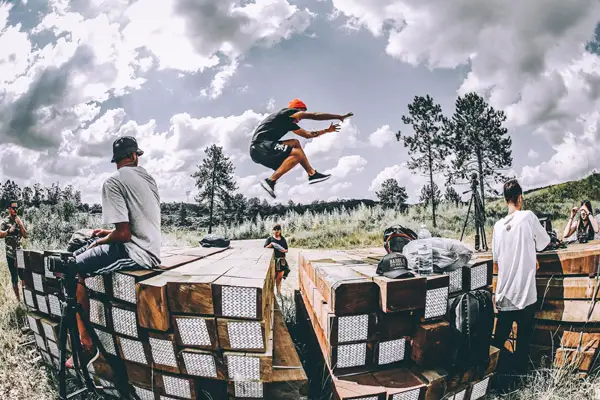
Why Use Lens Converters?
Given that lens converters are so much cheaper than new lenses or upgrading from your point-and-shoot to a DSLR setup, you might be wondering why you wouldn’t rely on a lens converter in all situations. There are reasons — good reasons not to use a lens converter.
But first, take a look at the upside.
The primary reason anyone buys and uses a lens converter is that they are the cheapest solution to a problem. That problem is often wanting to shoot subject matter that would be enhanced by being further away or closer to your camera. In reality, price is the one and only reason to use a lens converter.
The downside of lens converters ranges by the type of converter you’re using. For wide-angle lens converters, this can include making your point-and-shoot bulkier, as the converter won’t retract back into the body of the camera.
The primary issue many photographers have with lens converters, including wide-angle converters, is their negative impact on image quality. Nearly all wide-angle converters will cause vignetting, soft corners, chromatic aberrations, loss of sharpness, and heavy barrel distortion.
Negatives of Lens Converters
Vignetting
When the corners of your photos are darker than the center, you’ve got vignetting. Basically, the amount of light hitting the sensor on these outside edges is a little less than what is coming through from the center of the lens.
If you’re shooting with a DSLR, you’ll be able to go into the shooting menu and adjust the vignetting. If you don’t make the fix in your camera, it’s something you can also resolve during post-processing.
Soft Corners
Soft corners refer to the result of less definition in the extremities of your image. The bright side with regards to your photos having soft corners when shooting with a wide-angle converter is that all lens tends to cause soft corners to one degree or another so it’s not a huge problem. The key will be if the lack of definition you get when shooting with the wide-angle converter bothers you or not.
Chromatic Aberrations
If you notice color fringing or purple fringing in your photos, you’re looking at chromatic aberrations. These aberrations usually occur when your lens is unable to bring all the different wavelengths of color to the same focal plane. Chromatic aberrations are caused by lens dispersion, which results in an image looking blurred or with oddly colored edges. This is especially true in high-contrast images.
Loss of Sharpness
Loss of sharpness is the chief complaint people have about wide-angle converters. The loss of sharpness is often due to the converter limiting the amount of light coming into the camera, resulting in the need for longer shutter speeds.
Barrel Distortion
Barrel distortion is a type of optical distortion that causes straight lines in your image to curve inward as if you’re looking at the bottom of a bowl or barrel. This type of distortion happens when your image sensor is narrower than your field of focus, which often occurs when using a wide-angle converter. To compensate for the difference, the camera tries to squeeze everything in to fit, resulting in the distortion.
Is It All That Bad?
The truth is, all of those “downsides” to a wide-angle converter can be a lot of fun to play with — assuming you’re wanting to be a bit more artistic with your photography. However, they can be difficult to control for, so you might be stuck with whatever your results are, unless you’re very adept with Lightroom or Photoshop.
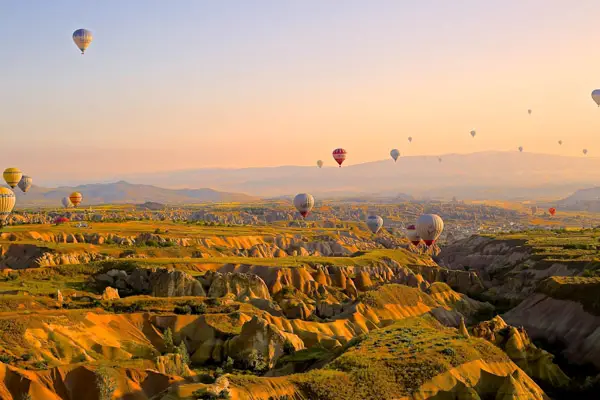
Advantages of Wide Angle Shooting
The main advantage of wide angle lens converters is that they, by definition, have a wider field of vision than the human eye. Because of this, they are most often used when you want to capture as much of a scene as possible, such as when you’re shooting landscapes, interior, architecture or cityscapes.
The key thing to remember when you decide to start shooting with a wide angle lens or use a wide angle lens converter is that they will distort the image and enhance perspective. The object closest to the lens appears significantly larger than objects farther away — even if they look about the same size with your naked eye.
You will want to take advantage of this particular type of distortion caused by wide-angle shooting. However, doing so can be intimidating because it often means getting within inches of your subject matter to force the viewer to focus on that object while still taking in everything else captured in the image.
Another reason to get super close to your subject is that it’s easier to have objects in the midground and background as well. This creates more depth and perspective.
Wide angle shooting is also very popular for interior or real estate photographers. This isn’t because there is a desire to be artistic with the type of distortion a wide-angle lens offers, but because it allows you to capture more of the room when your back is against the wall — literally.
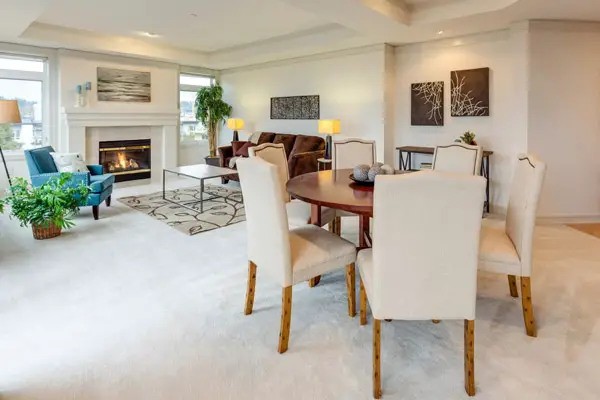
How to Choose a Wide Angle Lens Converter
Now let’s take a look at choosing the right wide angle lens converter for your needs.
Fitting Your Converter
When buying lenses, you’re probably used to considering the type of mount the camera has. For example, an EF or EF-S mount for Canon DSLR cameras.
However, a converter fits on the front of your existing lens and uses a completely different measure.
Take a look at the front of the lens that you want to use with your converter. You’ll see that there are threads that you can screw something onto. If you’ve ever used a filter with your lens, this is the same connection point.
Sizes come in millimeters. For example, 55mm or 62 mm. To find out your lens’ size, look for the ⌀ (diameter) symbol on your lens. The thread size will be written ⌀55, ⌀62, etc.
What if the converter you find doesn’t fit the lens you want to use? You can get step-down or step-up rings to make the conversion. These rings are also helpful if you want to use your converter with a couple of different lenses that do not have the same size threads.
Wide Angle Plus Macro
Some wide angle converters do double duty. They convert your lens to both wide angle as well as macro.
These converters usually have two pieces. Use them together to have a wide angle converter or use the macro converter separately to magnify your subjects. This type of converter makes an already inexpensive substitution even more cost effective.
The 8 Best Wide Angle Lens Converters on the Market
Ready to get started playing around with a wide angle lens converter? Check out one of these top-rated options to make sure you’re getting a good deal.
Altura Photo Professional 0.43x with Macro
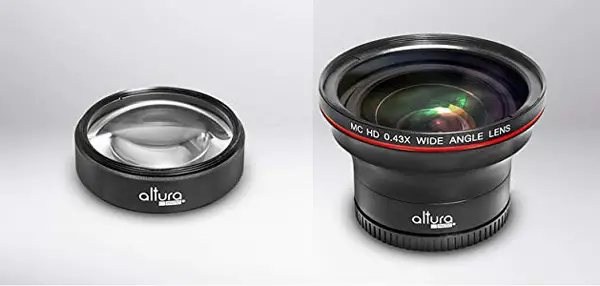
This converter offers considerable bang for your buck. As a cool bonus, it also comes with a removable macro portion.
With a 0.43x conversion rate, a 50mm lens effectively becomes 21.5mm. Reviewers report that vignetting and optical blur when used with a 50mm is not too bad. On an 18-55mm kit lens, reviewers mention that it works best when used above 24mm. Anything lower than that has noticeable vignetting and blur.
The optics are covered with a special coating to help cut down on distortion and glare. The lens also keeps the ability to use AF, zoom, and auto exposure. Thread sizes include 52mm, 55mm, and 58mm.
Neewer 0.43x with Macro
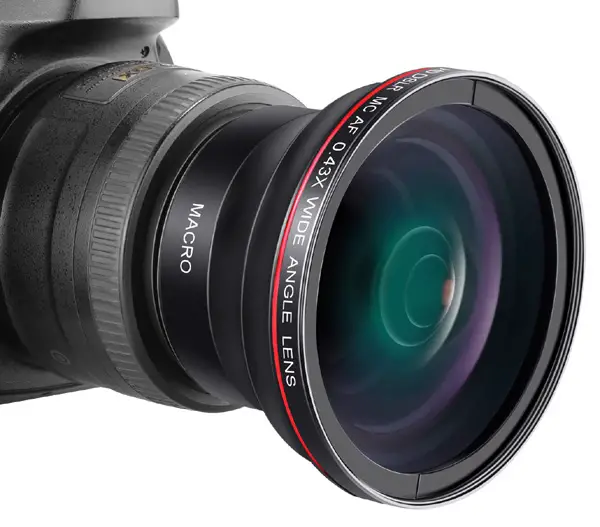
This converter is similar to the Altura one we just mentioned. It is slightly less expensive, but also offers the detachable macro lens.
The conversion rate is the same, 0.43x. So you can expect a similar focal length conversion.
The lens uses HD optical glass, cutting down on lens flare and glare. Reviewers expressed surprise with the high image quality, considering how inexpensive the converter is.
This converter also comes in 52mm, 55mm, and 58mm thread sizes.
Kenko SGW-05 0.5x
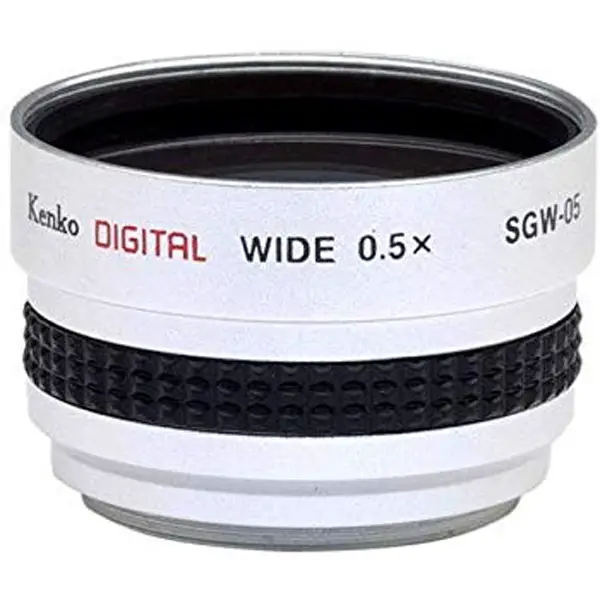
For compact digital cameras or camcorders, this Kenko converter is a great choice. Again, inexpensive, this fits on the smaller 37mm thread size.
With 0.5x magnification it essentially doubles your field of view. Reviewers report that you can see significant vignetting when zooming all the way out, but that tightening it up a little takes care of it.
Raynox HD-6600 Pro 0.66x
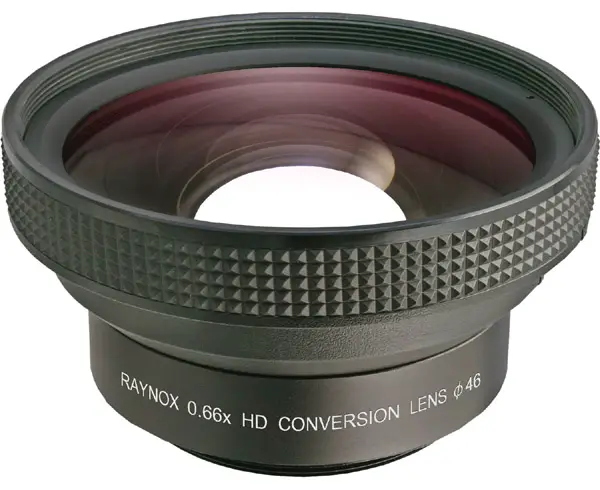
If you’re willing to spend a little extra money, you can get this Raynox. The lens retails for over $100. It’s more spendy than others on this list, but in return it cuts down on distortion significantly even when used with zoom.
Remember, it’s still much cheaper than buying a dedicated wide angle lens. So if you’re looking for something you can play with but will give you better results than the cheapest options, this lens is a great choice.
At 0.66x it nearly doubles the field of vision. It comes in a wide range of thread sizes including 37mm, 43mm, 46mm, 49mm, 52mm, 55mm, 58mm.
Raynox DCR-732 0.7x
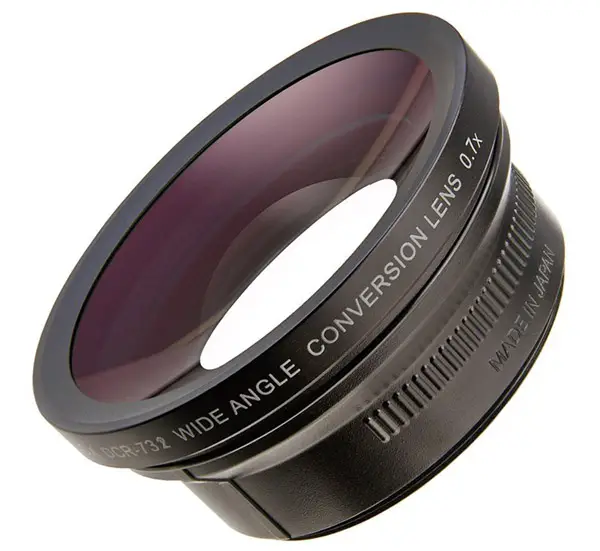
If you want something a little more middle-of-the-road, try this other Raynox option for under $100. This converter offers about 37% more viewing area. It effectively makes a 50mm lens into 35mm.
High index coated glass with a steel barrel offers a sturdy construction. Reviewers report no noticeable distortion as well as the image stays sharp even when zoomed.
The only size is 52mm, but includes adapter rings for 37mm, 43mm, and 46mm.
Zeikos 0.18x Super Fisheye Lens
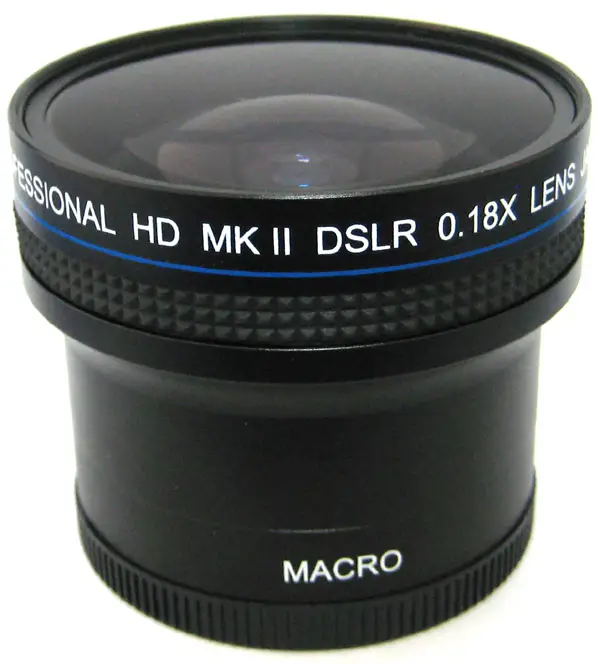
Want to play with some cool fisheye effects without dropping the cash on an expensive fisheye lens? This 0.18x from Zeikos will widen up your photos considerably. Consider that at this magnification 50 mm becomes 9mm.
The lens takes circular photos so you can use it to achieve some interesting and artistic effects.
The lens uses high quality, coated optical glass. A steel barrel construction makes sure that it’s sturdy.
Helder EW-4537 HD 0.45x
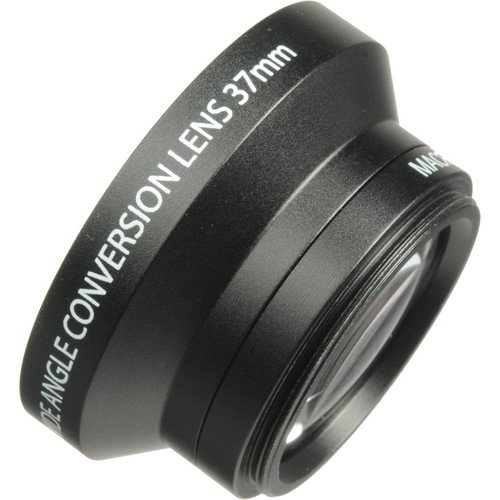
This lens will open up your view of view considerably, without adding too much of a fisheye effect to your photo. The 0.45x magnification will open up a 50mm to 22.5mm.
The lens is reasonably priced and described as having high definition quality.
Opteka OPT45X58SWA 0.45x High Definition II
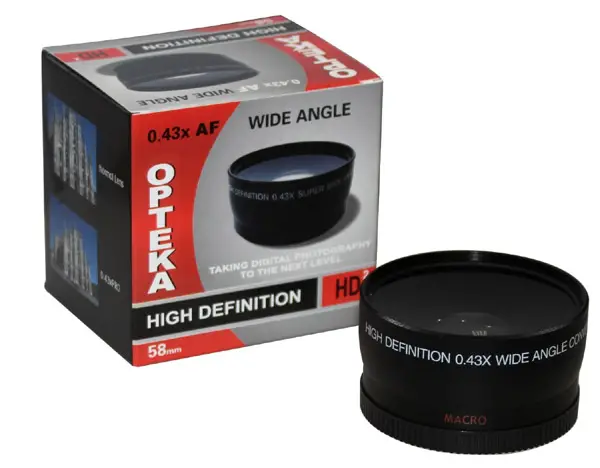
Another high definition option, this converter is a little bit cheaper than the last one we mentioned.
Reviewers mentioned that it doesn’t work well at long focal lengths above 180mm. The edges begin to show streaks and start to blur. Works well with any focal length shorter than that, however.
Explore the Wide World
Now we’ve learned all about wide angle lens converters and looked at a few that are worth trying. What do you think, will wide angle lens converters work for you?
Wide angle lens converters definitely have their place. Good ones can even be dirt cheap and are a great way for photographers to get their feet wet with wide angle and macro photography.
If you’re just playing around with different effects and techniques, the converter is well worth the money. However, if you’re planning to take professional real estate or landscape photos, you may want to invest in the real thing.
Here is the video:
Curious why those wide angle lenses are so expensive? Check out this post to learn all about them!









1 comment